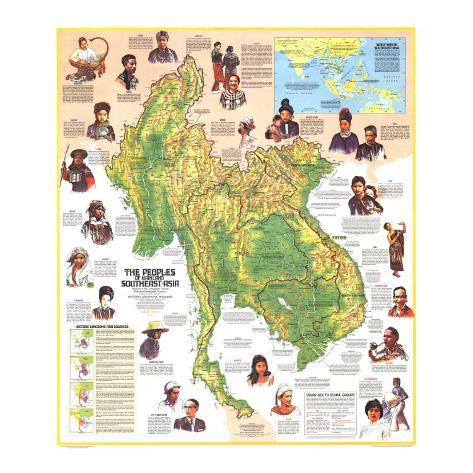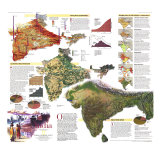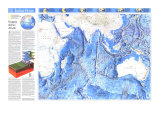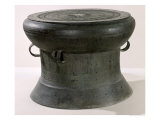The 1971 Peoples of Mainland Southeast Asia map features:
• Detailed insets of the main ethnicities of the region with illustrations
• An abundance of information about the geography, history, and religions of the region
• Historic kingdoms and colonies
• Color key to ethnic groups
• Early Man in Southeast Asia inset
* Lesson plan idea - have your students update the information, discuss the political, economic, and environmental situations at time of publication and at date of their research. • maps
EARLY MAN IN SOUTHEAST ASIA
Fossils found in Java indicate man's presence in Southeast Asia more than 500,000 years ago, but until recently little was known of the long span between that time and the early centuries of the Christian Era, when the first historical kingdoms rose in the area. Many archeologists have regarded prehistoric Southeast Asia as a relatively passive land–a cultural cul e sac of ideas and influences from neighboring regions. Recent evidence, however, though sparse and as yet uncorrelated, suggest that Southeast Asians made early and important strides of their own: in the cultivation of vegetables and other staples around 10,000 B.C., and in the development of polished stone tools, pottery, and implements of bronze. Continued research may reinforce one archeologist's appraisal that Southeast Asia “added to world and Western culture as much or more than it received.”
Dong Son (northern Vietnam) gives its name to a Southeast Asian bronze-and-tin culture of around 300 B.C. Its most distinctive products were massive bronze drums, sometimes decorated with images of animals an men.
HISTORIC KINGDOMS AND COLONIES
Except in the Chinese-influenced Viet kingdoms, the major realms and cultures of mainland Southeast Asia combined local customs with the religions and political influences of India. Through the centuries these cultures retained their essential Indian characteristics. The mixture inspired the building of unique religious and royal centers such as Angkor and Pagan.
INDOCHINA - Reflecting the position of mainland Southeast Asia between India and China, the name Indochina has two principal meanings. Politically, it applies only to Viet Nam, Laos, and Cambodia, which made up French Indochina. Physical geographers extend the term to include Thailand, Burma, and the Malay Peninsula. The lower peninsula, however, more closely relates to island Southeast Asia and is not shown in detail on this map.
FUNAN - From its beginning in the first century, this state prospered by its position on the trade route between India and China. Funan exchanged embassies with both countries and at its zenith was the dominant state of the region. In the fertile marshlands of the Mekong Delt, the Funanese built canals to control floods and limit the intrusion of salt water.
PYU - After the third century A.D., Tibeto-Burman tribesmen migrated from the north into present-day Burman and in 638 founded the Buddhist capital of the Pyu Kingdom at Srikshetra (today called Hmawza). Early seventh-century urn inscriptions bear Hindu names of Pyu kings.
CHAMPA - The Hindu-influenced Kingdom of the Chams rose in the second century A.D. and for 1,200 years struggled to remain independent of the expanding Dai Viet and Khmer Kingdoms. In 1177 the Chams sailed up the Mekong, defeated the Khmers on the Great Lake, and sacked Angkor. A century later Champa joined forces with Dai Viet against Kublai Khan; 200 years later Champa succumbed to its former ally.
DVARAVATI, THATON, AND PEGU - These Mon kingdoms ranging from the 6th to the 16th century had a lasting influence upon the culture of mainland Southeast Asia. They spread the Buddhism that ultimately became the faith of the people of Burma, Thailand, Cambodia, and Laos.
CHENLA - the Khmer people of Chenla overthrew Funan in the sixth century. Their realm was long split into two distinct regions, Water Chenla (Mekong Delta area and present-day Cambodia) and Land Chenla (upland area of the middle Mekong Valley). From this divided kingdom emerged the powerful Khmer Empire.
KHMER - In the ninth century the Chenla Dynasty set up its capital at Yasodharapura–the present site of Angkor–which became the center of a vastly expanded Khmer Empire. Here its kings received Indian scholars, artists, and religious leaders. The Siamese ravaged Angkor in 1431.
PAGAN - This Burman empire developed after the fall of Pyu. The capital city, also called Pagan, with its thousands of Buddhist temples and pagodas, drew pilgrims from Mon areas and from Ceylon. After the 13th-century Mongol invasion the empire declined, and Shan princes assumed rule over the northern portions of the divided realm.
DAI VIET - the Vietnamese gained independenceby rebelling against the Chinese in the tenth century. Gradually, they expanded to the south at the expense of the Chams. Though traditionally hostile to Chinese interference, the Vietnamese absorbed much of Chinese character; industrial and agricultural techniques adopted from the north made them among the best farmers on the Southeast Asian mainland.
KAMBUJA - The Khmers abandoned Angkor in the 15th century and established a new capital at Lovek. Siam repeatedly invaded their once-mighty empire, but they held to their chief rice-farming lands around Tonlé Sap.
BURMA - The Toungoo Dynasty united Burma in the 16th century after 300 years of divided rule under the Shan and Mon. From the 16th century Burma repeatedly expanded its frontiers eastward into Siam. Britain annexed Burma as part of the Indian Empire in the 19th century.
SIAM - By the early 13th century the Thai had extablished a capital at Sukhothai. Then in 1350, the political center moved south to Ayutthaya. Siam–today called Thailand–remains the only kingdom of mainland southeast Asia never colonized by the West.
LAOS - The Laotian Kingdom of Lan Xang, first established by a Lao monarch in the mid-14th century, encompassed all the present-day Laos and much of northern and eastern Thailand, In 1697 Lan Xang split into three rival states which for nearly two centuries wrangled among themselves while fighting off outside invaders. in 1893 the region became Laos, a French protectorate.
UNION OF INDOCHINA - In the 19th century, as European nations competed to colonize Asia, the French organized the Union of Indochina. The protectorates of Cambodia, Laos, Tonkin, and Annam, and the colony of Cochin China remained under French control until 1953, except for Japanese occupation during World War II.
AKHA - Elaborate headdress and jewelry mark this woman (illustration) as an Akha. Her people grow rice in the hills of northern Laos and adjacent Burma, Thailand, and China. Akha villages, guarded by sacred gates erected to keep out evil spirits, generally lie at elevations of 3,500 to 4,000 feet.
BLACK THAI - Rice-farming Black Thai, so called for the black garb of their women, dwell mainly in the upland valleys of northern Viet Nam and Laos. Similarly, clothing distinguishes Red Thai and White Thai. Among some of these groups in Viet Nam, family affiliation determines status and occupation. Thus, some families form a local political elite, while others furnish religious leaders, soldiers, artisans, or farmers.
BURMAN - Burman-speaking people growing wet rice and trading in pottery, lacquer ware, and metal products have lived in the lowlands of central and southern Burma for at least a thousand years. For as long a time, the harp has been popular among them. Buddhism and writing came to them early from the Indianized Mon civilization. Subsequent generations established not only a succession of powerful dynasties, but also sophisticated statecraft and a rich literary and artistic tradition. The ethnic designation “Burman” should not be confused with “Burmanese,” which refers to all the inhabitants of Burma.
CHAM - Chans of Viet Nam and Cambodia trace their ancestry to Champa, a kingdom that blended Hinduism and Islam. Now nearly all Moslem, they number 50,000 in Viet Nam and about 100,000 in Cambodia. Some Chams today seek political independence, hoping to revive the status of their fallen kingdom.
CHIN - Wooden beads and har parted in the middle identify this woman (illustration) as a Chin. During the late 1800's and early 1900's these upland rice farmers stubbornly fought the British occupation of their realm in Burman, India, and East Pakistan. Today half of Burma's 655,000 Chin live in a special area in western Burma.
CHINESE - Colonial conquest of theRed River Delta by the Emperor Ch'in Huang-ti in 218 B.C. brought strong chinese influence to this area. some hill farmers filtered down from China to settle among the northern tribesmen, but most came as itinerant traders and laborers. Now clusting in ports and urban centers, they carry on much of Southeast Asia's trade and commerce. Many maintain dual cultures, observing their adopted land's customs and language in business dealings while preserving their Chinese identity in family life.
KACHIIN - A name ormerly applied to differnt hill peoples of northeast Burma, Kachin on this map refers only to groups speaking Jinghpaw and closely related languages of the Sino-Tibetan family. The women ornament themselves with mantles of silver tassels and disks. Kachins live principally by shifting cultivation of dry rice, and trade with the valley-dwelling Shans.
KAREN - These peoples of the hills in and around Kawthule (formerly Karen) State in southeastern Burma, in western Thailand, and in the Irrawaddy Delta vary in economy and religion; many Karens are Christians. Most live by wet-rice farming. Some own elephants and work as mahouts in the teak forests. A closely related group of Karen, called Kayah, live in their own semi-autonomous state in Burma.
KHMER - Four of every five residents of Cambodia descend from the people of the Khmer civilization, which flourished from the 8th to the 15th century. Today's Khmer villagers are efficient lowland rice farmers. Their crops bring the country more than a third of its foreign exchange.
LAHU - Large silver edallionsadorn the women of the Lahu,mountain peopleof northern Thailandand the BurmaLaos-China border area. Generally, Lahu live at elevations of 4,000 feet or more. Though guns are used, men still hunt with crossbows and poisoned arrows. Between harvests of rice and maize, they plant the fields with opium poppies–a principal cash crop.
LAO - Thai-speaking Lao are closely related to the Siamese Thai, but differ in dialect and in their preference for eating sticky rice. The Siamese and Vietnamese regard the Lao as rustics. But not all Lao are rural; they form the majority in Vientiane, the administrative capital of Laos. An imposing Buddhist wat, or temple, dominates nearly every Lao village. Cultural and linguistic differences separate the Lao of northern Thailand from those of the northeast and Laos.
LISU - Exceptionally large turbans and silver bangles distinguish Lisu women from other mountain groups. The Lisu live in remote villages, at high altitudes. Though largely concentrated in China's Yunnan Province, many dwell in northeast Burma and northern Thailand. Lisu farmers raise poppies and rank with the Meo as major opium producers.
MEO - The color of a woman's dressoften identifies the subgroup–White, Red, Black, Flowered–to which a Meo of Viet Nam, Laos, or Thailand belongs. The majority, however, live in southern China, where they are called Miao. Man and women alike usually wear silver necklaces–often with a chain looped across the opening. The elevations of their villages–3,000 to 6,000 feet–favor the cultivation of opium poppies, their major cash crop.
MNONG GAR - One of many Mnong-speaking groups of southern Viet Nam and Cambodia, the Mnong Gar cultivate dry rice by slash-and-burn agriculture, which they term “eating the forest.” The men wear loincloths and–occasionally–jackets, necklaces, and bracelets. For esthetic reasons they file down their front teeth and insert ivory plugs in their ear lobes. Their villages, made up of communal longhouses each functioning as a separate political unit, closely resemble those of the Rhade.
MONTAGNARDS - Almost two million Mon-Khmer and Cham-speaking tribesmen occupy the rugged backbone of Laos, Viet Nam, and Cambodia. Known collectively as Montagnards–French for “mountain men”–these isolated hill folk view with suspicion and distrust the lowland Vietnamese, who in turn regard them as savages.
NAGA - Nagas of the rugged highlands along the Burma-India border vary in culture, physical appearance, and dialect, but retain enough uniformity in beliefs and economic practices to distinguish them from nearby Chins and Kachins.
RHADE - Upland rice farmers of southern Viet Nam, the Rhade live in villages notable for their distinctive longhouses built on piles. Partitioned into areas for work, social gatherings, and storage, the structures also include compartments occupied by family units or older members of the household.
SHAN - Shans dwell in permanent settlements along river valleys and in pockets of level land amid the hill country of northeast Burma, northwest Thailand, and southern China. Nearly all Burmese Shans are Theravada Buddhists, who until recently, lived within a distinctive structure of feudal states ruled by hereditary princes. The men usually wear turbans and are often heavily tattooed.
SIAMESE THAI - The name Siamese, here used for speakers of the central and southern Thai dialects, can also apply to all the peoples of historical Siam. Temple-monastery compounds in the villages reflect a centuries-old Buddhist tradition. For their livelihood, Siamese Thais depend almost entirely upon the cultivation of rice–mostly raised in lowland paddies and harvested by hand. Lampshade-like hat identifies this woman as a Siamese Thai (illustration).
YAO - Chinese use the name Yao to designate a scattered minority in southern China. These people, also found in northern Viet Nam, Laos, and Thailand, are called Man by the Vietnamese. Yao craftsmen produce not only the hill peoples' customary tools and weapons such as knives and crossbows but also rifles and paper. The men traditionally wear black caps; Yao women often add red-plush collars to their garments.
CITY DWELLERS - Customs, costumes, and languages–not facial characteristics–reveal the origins of southeast Asians. The increasing numbers who migrate to the cities often shed their ethnic identities and become assimilated. It is difficult to tell the background of a Saigon Vietnamese wearing a business suit or that of a hard-hat laborer in Bangkok. On the other hand, ethnic islands, such as the populous “Chinatowns” of Saigon and Bangkok, thrive in the cities.
AGRICULTURE - The production of rice employs more mainland southeast Asians than any other enterprise. “Wet rice” grows in irrigated fields, in lowlands with abundant rainfall, or in the floodplains of rivers. “Dry rice” grows in the highlands and relies on rainfall alone. Other important products: tea, maize, tobacco, sugar, cotton, copra, rubber, palm oil, teak, and opium. Many highland tribes farm by slash-and-burn agriculture–they cut and burn off the trees, plant crops for one or more years, then move to another hillside. Some return to the same place after leaving it fallow for 10 to 20 years.
OPIUM - Poppie scultivated in the hills where Burma, Laos, Thailand, and China's Yunnan Province converge are the source of an illegal but lucrativ opium trade. In December and january, after the flowers' petals fall off, the pods are slit; resin oozes out and hardens into opium. Addicts often smoke the drug in its raw state; it can also be converted into morphine and further refined into heroin.
RELIGIONS -
BUDDHISM dominates the religious thought of mainland Southeast Asia. In the Mahayana form, practiced in Viet Nam Buddhas (Englightened Ones) are objects of worship and meditation. The Theravada form necessitates more rigorous personal involvement and regards the original Buddha, Siddhartha Gautama (c. 563-483 B.C.) as a teacher. This form prevails in Burma, Thailand, Laos, and Cambodia. Through the Buddhist philosophy the individual strives for nirvana–an inner peace achieved by driving out desire, hatred, and delusion. Buddhism coexists with other beliefs without conflict or interference. A Vietnamese, for instance, finds nothing inconsistent in being Confucianist and Buddhist at the same time. Most Buddhist men spend at least a few months of their lives as monks. Saffron-robed, they walk the streets collecting food from donors who thereby acquire spiritual merit. Buddhism has inspired the building of many thousands of temples and shrines throughout Southeast Asia.
The religious make-up of Viet Nam differes significantly from that of Burma, Thailand, Laos, and Cambodia. Though the majority of Vietnamese are Buddhists, Confucianism underlies the entire social and religious structure. A magical and astrological form of Taoism has also spread through this land. In addition, some two million follow the Roman Catholic faith; as many practice Cao Daism– a synthesis of Confucianism, Taoism, Buddhism, and Catholicism; more than a million adhere to the Hoa Hao faith, a variation of Buddhism.
ANIMISM is an age-old belief that spirits live in such natural objects as trees, rocks, and mountains. Followed by many highland tribes, it often involves animal sacrifices to exorcise or placate evil spirits. In some tribes animism and ancestor worship are practiced side by side with the formal religions.
VIETNAMESE - Vietnamese-speaking peoples ... farm Viet Nam's coastal lowlands and the deltas of the Red and Mekong Rivers. They make up 85 percent of Viet Nam's 39 million people. Chinese influences, including the use of Chinese characters and Confucian respect for ancestors, pervades Vietnamese culture. Women dress up in the traditional high-collared ao dai; conical hats are commonly worn by both men and women.
UNION OF BURMA - Part of Great Britain's Indian Empire for more than half a century, Burma gained independence in 1948. it established semi-autonomous states for the Karens, Shans, Kachins, and Kayahs, and a special division for the Chins. Of the 28 million Burmese, these five ethnic groups make up 17 percent. Burmans living in the lowlands of the Irrawaddy River Basin and the Tenasserim coast total 70 percent. The rest include Chinese, Indians, and scattered tribal groups. The Indian minority continues to shrink as its members emigrate to India. Since 1962 a military junta has led Burma's Socialist governement, which maintains a policy of neutrality in world affairs.
CAMBODIA - This country became the Khmer Republic in 1970 but remains popularly known in English as Cambodia–a derivation from the ancient name Kambuja. A part of the Union of Indochina until 1953, the nation now struggles to maintain its independence in the face of a war that spills across its borders from Viet Nam. Cambodia's seven million people–mostly Khmer–crowd along the Mekong and around the Tonie Sap.
LAOS - The French created a portectorate here in 1893; the country gained independence 60 years later. Of its three million people, 47 percent are ethnic Lao. Now the Communist-led Pathet Lao and the Royal Lao Army fight for control of the “Land of the MillionElephantsand the White Parasol.”
VIETNAM - When Allied victory ended Japan's World War II occupation of the Union of Indochina in August 1945, the Communist-controlled Viet Minh created a Vietnamese republic embracing Tonkin, Annam, and Cochin China, with Hanoi as captial. The Frech re-established themselves in 1946. The fighting that broke out between them and the Viet Minh in December 1946 lasted until 1954. In May, a French force surrendered at Dien Bien Phu, and in July the Geneva agreements established a military decarcation line; the Viet Minh were to withdraw to the north of it, the French and those allied with them to the south. During the following year, the French quit the country, leaving behind the Vietnamese government they had established in Saigon. The demarcation line, never intended as a political or territorial boundary, nevertheless split the country into two parts: the Democratic Republic of Viet Nam–popularly, North Viet Nam; and the Republic of Viet Nam–called South Viet Nam. Each government demands reunification on its own terms.
HO CHI MINH TRAIL - An extensive network of routes from northern Viet Nam through Laos and Cambodia, over which men and supplies flow to Communist forces in southern Viet Nam and Cambodia. The trail's name, popularized by the Western press, refers to the late President of North Viet Nam.
MONSOONS - Monsoons are periodic wind systems that reverse directions during the year. Over mainland Southeast Asia they create two distinct seasons. Usually from October to April or May the northeast monsoon brings cool, dry weather. The southwest monsoon brings heavy rains, high humidity, and high temperatures from about May to September.
MEKONG - Called the “River of the Nine Dragons” for its many-mouthed delta, the Mekong rises high in the Asian heartland and travels 1,100 miles through Tibet and China before entering the area of this map. For much of its remaing 1,500 miles the river forms the border between Burma, Laos, and Thailand; some 30 million people live it its lower basin. Most traffic in the Mekong Delta moves on tributary canals, a complicated network of man-made waterways that take the place of highways in a nearly roadless land.
TONKIN - From the 15th to 18th century the capital of Dai Viet was Hanoi, at one time called Dong Kinh. Visiting Europeans applied the name Tongking to the surround area. The French named the region Tonkin in 1883 and included it in the Union of Indochina.
ANNAM - Seventh-century Chinese colonist called this region Annam, meaning “pacified south.” The indigenous people referred to it as Nam Viet and, later, Dai Viet. The French used Annam to disignate the region of present-day Viet Nam stretching along the S-shaped coast from Tonkin to Cochin China. Until the end of World War II foreigners referred to the people of this area as Annmites of Annamese, but they have always called themselves Vietnamese.
ANGKOR - In the tenth century, before the building of Europe's great cathedrals, a splendid capital took shape in the Khmer Kingdom. Sacked by Thais in 1431, it lay forgotten for four centuries–cracked by the tropical sun, lashed by monsoon rains, torn apart by jungleroots. in 1860 French naturalist Henri Mouhot stumbled upon the ruins and wrote of Angkor's hidden wonders. Archeologists have since uncovered most of the city, including Angkor Wat–the intricately sculptured city temple designed as a symbolic abode of the gods and as a mausoleum for the ashes of King Suryavarman II.
BANGKOK - Thai call their capital Krung Thep –“City of the Angels.” Westerners once knew Bangkok as an Asian Venice, but most canals have been filled to accommodate wheeled traffic. The city and Thon Buri across the river now form a bustling, modern metropolis of almost three million people.
HANOI - Capital (1887-1945) of the French Union of Indochina and now that of the Democratic Republic of Viet Nam (North Viet Nam).
HUE - Once the Vietnamese imperial capital and a Cham center, Hue and its people suffered severely from ground combat and bombing during the 1968 Tet offensive.
RANGOON - Rangoon takes its name from Yangon–“End of Strife”– given to the city in 1755 by its founder, King Alaungpaya, to mark his victory over the Mons. Two gilded pagodas, Sule and Shwe Dagon, dominate the capital's skyline.
SAIGON - Once called the “Paris of the Orient,” Saigon has traded its leisurely atmosphere for the ailments of a modern metropolis. Refugees from the Vietnamese war have made this one of the most densely populated cities in the world. Cholon, the Chinese section, holds 850,000 people–about a fourth of Saigon's population.















